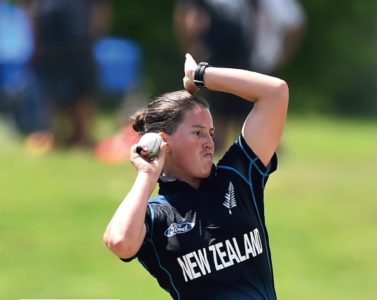To reach the pinnacle in any sport, one needs drive and devotion. These qualities have been exemplified by one Auckland Hearts’ and White Ferns’ cricketer, in particular, over and over again. But, just as money makes the world go ‘round, it also keeps international sport in spin. JON RAWLINSON explains.

Good sports don’t necessarily make great money. While Rugby’s Black Ferns – who claimed their fifth Women’s World Cup earlier this year – may still be battling for professional contracts, their cricket counterparts are somewhat better off.
White Fern, and Auckland Hearts’ all-rounder, Holly Huddleston, says a deal secured last year has made her (for one) better prepared to compete on the international stage.
“It’s a weight off my shoulders. I don’t need to worry about having only a few hours [to train] after or before work; I can just get on with it,” the former Papakura local explains. “It’s important we get enough so we can really put good performances on the park and help grow the game.”
Following last year’s increase for contracted players, White Ferns receive somewhere in the 20-40k per annum ball park. I don’t ask Holly exactly how much she receives – my mum always said that was vulgar – but at least she can keep her bank balance in the black while pursuing her passion fulltime.
To put this into some perspective, a former Rosehill College schoolmate of Holly’s who’s reached an equivalent level in his sport benefited from a pay rise last year. However, as All Black captain, Kieran Read is thought to earn more than Holly per annum; about a million dollars more.
“To be honest, I don’t think I ever said more than one or two words to him back then; he was head boy and I was just a little fifth former,” she laughs. “Kieran was always good at cricket too so I actually thought he could’ve gone on to be a Black Cap.”
Okay, so achieving pay parity may still be some way off, but Holly remains philosophical; ultimately it’s the number of fans in the stands which determines whether cricket’s women receive a fair amount of money for their runs.
“Women’s sport (in general) is more in the spotlight these days, which is awesome, and with the contracts we have now, it’s looking up,” she adds. “More people are taking notice, which means more games, more sponsors and that’s where the money comes in.”
Having grown up in Papakura watching cricket with her mum, Holly was always keen on the sport, but the decision to leave a solid day job behind her in 2015 wasn’t taken lightly.
“After my first year [playing for the White Ferns], my fitness let me down. I felt I couldn’t really progress in cricket because I couldn’t give as much time to it as it needed,” she says.
“I wanted to play in England [Middlesex] which meant I’d need to stop working. It was very scary. My parents were awesome, really supportive. They said, as it was my dream and I only had a short time when I’d be able to do it, they would help me out.”
While playing English County Cricket can result in quite the windfall for batsmen, its batswomen are not paid to play, although Holly confirms her accommodation was provided and she secured some paid coaching gigs.
Originally a keeper, Holly set aside the gloves to focus on bowling when playing with the Northern Districts Spirit. It would prove an important step in her career. Since her debut for New Zealand in early 2014, the fast-medium has become a spearhead of the Ferns’ bowling attack in T20 and One Day formats.
Although she considers test cricket to be the pinnacle of the old leather on willow code, this wily wicket-taker is unlikely to doff a test cap.
“Unfortunately, we don’t [play tests] anymore,” she explains. “I think it just comes down to time and scheduling. I would love to play one; as a bowler there’s more strategy, more overs and plenty more opportunities to give it your best.
“I feel the women’s game needs a return to test cricket. To be fair, though, I really think T20 is the way to go when it comes to promoting women’s cricket. Hopefully, the fan base that could build up as a result may allow the funding for tests to return.”
Maintaining match fitness can also prove problematic for New Zealand’s finest female cricketers who play far fewer fixtures at the top level than the Black Caps.
“We don’t play as often as the men but the amount [of international cricket] we’re playing is on the increase,” she confirms. “We’re also getting to play overseas against different opposition more often too, which is important.”
Settling scores…
During this summer’s women’s One Day and T20 competitions, the Auckland Hearts will be hoping a return to title fame is on the cards. Papakura-raised all-rounder, Holly Huddleston, will likely prove a particularly thorny customer for batters to manage.
“Batting is still a massive ‘work on’ for me; bowling is my biggest strength. I’ve been working on changing up the ball at the death in T20s and that’s when my ability to swing the ball really comes into its own,” she reveals.
“I’ve probably taken a few more wickets than I’ve hit sixes. Hitting a six is just unbelievable but you can’t beat the feeling from taking a wicket; it’s such a rush, especially when you bowl an absolute jaffa and the batter has no hope of even getting close to it, that feels fantastic!”
Fresh laurels during the domestic season could go some way to soothing the agony which resulted in more than just one ‘broken Heart’ during the Women’s Cricket World Cup earlier this year. “We were all very disappointed. [White Ferns’ captain] Suzie Bates hit the nail by saying we just didn’t perform as we should have against the best teams; it just didn’t happen,” the fast-medium says.
The team’s bid for a second World Cup ran as short as their run chase, managing a mere 79 in response to India’s 265.
“India turned up to the park and we didn’t. We bowled really well to keep them to an average score but we just didn’t back it up with the bat. I didn’t play that game. It’s not the best to be dropped, first and foremost, but then for the game to go the way it did was just awful! I felt helpless because with no control over the situation; the best I could do was run on drinks.”
I suggest a few drinks afterward may have helped too; she laughs. She’s right to remain positive because, in sport, there’s always another cup around the corner. Come next November, Holly hopes she and her team can deliver some sweet revenge during the T20 World Cup in the West Indies.
Recently, the Ferns made some impressive progress on the road to retribution, picking up two wins from three ODIs followed by a clean sweep of the four-match T20 series against Pakistan during a short tour of the UAE. Their next campaign will be a home series against the ‘Windies’ early next year.
“Playing at home is massive for us. It’s a little bit chillier here than in the West Indies, so they might not like it too much,” Holly laughs. “But they are a force to be reckoned with. We’d be confident, but it all comes down to what happens on the day.”











